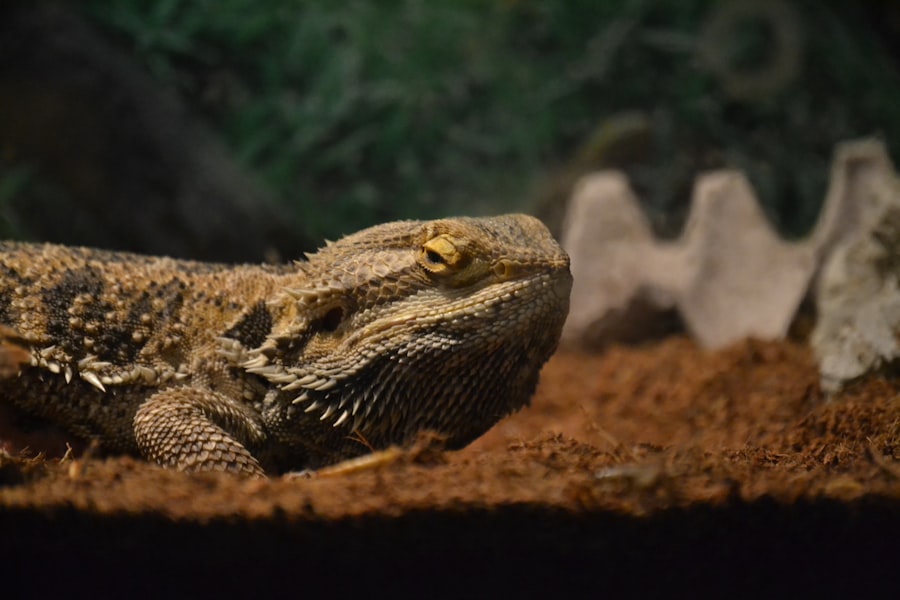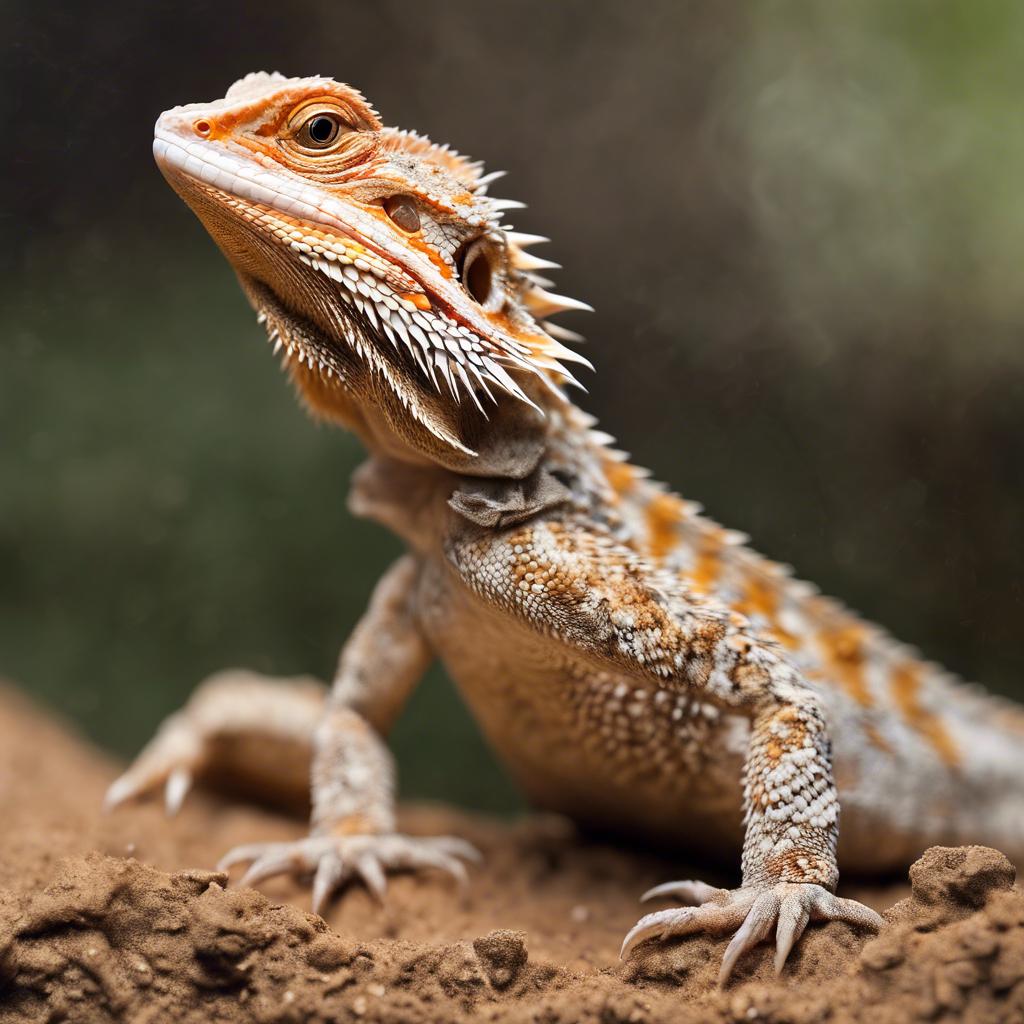Bearded dragons, scientifically known as Pogona, are a type of lizard native to Australia. They are popular pets due to their unique appearance and docile nature. Bearded dragons get their name from the spiky beard-like scales under their chin, which they puff out when they feel threatened or excited. These reptiles have become increasingly popular as pets in recent years, and for good reason.
Bearded dragons make great pets for several reasons. Firstly, they are relatively easy to care for compared to other reptiles. They have simple dietary needs and are generally hardy creatures. Secondly, they have a calm and friendly temperament, making them suitable for both experienced reptile owners and beginners. Lastly, bearded dragons are highly interactive pets. They enjoy being handled and can form strong bonds with their owners.
Key Takeaways
- Bearded dragons are popular pets due to their docile nature and unique appearance.
- A 9-month-old bearded dragon will have grown significantly and require a larger enclosure.
- Housing for bearded dragons should include a basking area, hiding spots, and appropriate substrate.
- Bearded dragons require specific temperatures and lighting to maintain their health.
- Feeding bearded dragons a varied diet and providing fresh water is crucial for their well-being.
Characteristics of a 9-Month-Old Bearded Dragon
At 9 months old, a bearded dragon is still considered a juvenile but has already gone through significant growth and development. In terms of size and weight, a 9-month-old bearded dragon can measure around 12-16 inches in length, with males typically being larger than females. They can weigh anywhere between 200-400 grams.
Coloration and patterns can vary among bearded dragons, but at this age, they typically have vibrant colors and distinct patterns. Their scales may range from shades of brown, tan, yellow, or orange, with some individuals displaying hints of red or blue. The patterns on their bodies can include stripes, spots, or even a combination of both.
In terms of behavior and temperament, 9-month-old bearded dragons are generally active and curious. They enjoy exploring their surroundings and may display playful behaviors such as chasing after insects or climbing on branches. However, they are also known for their calm demeanor and can often be found basking under their heat lamp or lounging on a comfortable perch.
Housing Requirements for Bearded Dragons
Providing the right housing for your bearded dragon is crucial for their overall health and well-being. The size and type of enclosure are important factors to consider. A 9-month-old bearded dragon will require a spacious enclosure that allows them to move around comfortably. A 40-gallon tank or larger is recommended, with a secure lid to prevent escape.
When it comes to substrate options, there are several choices available. Newspaper or paper towels are commonly used as they are easy to clean and replace. Reptile carpet is another option that provides a more naturalistic look while still being easy to clean. Avoid using loose substrates such as sand or wood chips, as they can pose a risk of impaction if ingested.
Decor and hiding spots are essential for creating a stimulating and enriching environment for your bearded dragon. Provide branches, rocks, and logs for climbing and basking. Hiding spots such as caves or hollow logs should also be provided to give your bearded dragon a sense of security. Additionally, adding live plants can help create a more naturalistic habitat.
Temperature and Lighting Needs of Bearded Dragons
Maintaining proper temperature gradients is crucial for the health and well-being of your bearded dragon. They require a basking spot with a temperature of around 95-105°F (35-40°C) during the day, while the cooler side of the enclosure should be around 75-85°F (24-29°C). At night, temperatures can drop slightly, but should not go below 65°F (18°C).
Proper lighting is also essential for bearded dragons. They require both UVA and UVB lighting to meet their physiological needs. UVA lighting helps stimulate natural behaviors and promotes overall well-being, while UVB lighting is necessary for the synthesis of vitamin D3, which is crucial for calcium absorption and bone health.
UVB lighting should be provided for 10-12 hours a day, and the bulbs should be replaced every 6-12 months, as they lose their effectiveness over time. It is important to place the UVB bulb within the enclosure at an appropriate distance to ensure that your bearded dragon receives the necessary UVB exposure.
Feeding and Watering Bearded Dragons
Bearded dragons are omnivorous, meaning they eat both plant matter and insects. A balanced diet is essential for their overall health and growth. Juvenile bearded dragons should be fed a combination of insects such as crickets, mealworms, and dubia roaches, as well as a variety of leafy greens and vegetables.
At 9 months old, a bearded dragon should be fed a combination of insects and plant matter daily. Offer insects such as crickets or dubia roaches 2-3 times a day, providing as many as they can eat in a 10-15 minute period. Leafy greens and vegetables should also be offered daily, with a variety of options such as collard greens, kale, dandelion greens, and squash.
Watering needs for bearded dragons can be met through regular misting of their enclosure or by providing a shallow dish of water. However, it is important to note that bearded dragons do not typically drink water from a dish and may prefer to obtain moisture from their food or through soaking in shallow water.
Handling and Socialization of Bearded Dragons

Handling your bearded dragon is an important aspect of their care. Regular handling helps them become accustomed to human interaction and can help build trust between you and your pet. It is important to handle your bearded dragon gently and with care to avoid causing stress or injury.
To properly handle a bearded dragon, it is recommended to support their body with both hands, one hand supporting the front half of their body and the other supporting the hindquarters. Avoid grabbing or squeezing their body, as this can cause discomfort or injury. Allow your bearded dragon to crawl onto your hand or arm and let them explore at their own pace.
Socialization with other pets should be approached with caution. While bearded dragons are generally docile and non-aggressive, they may become stressed or frightened by the presence of other animals. If introducing your bearded dragon to other pets, such as dogs or cats, it is important to closely supervise the interactions and ensure the safety of all animals involved.
Common Health Issues in Bearded Dragons
Like any pet, bearded dragons can experience health issues. It is important to be aware of the signs of illness and seek veterinary care if necessary. Some common health issues in bearded dragons include respiratory infections, metabolic bone disease, parasites, and impaction.
Signs of illness in bearded dragons can include loss of appetite, weight loss, lethargy, abnormal stool, difficulty breathing, or changes in behavior. If you notice any of these signs or suspect that your bearded dragon may be unwell, it is important to consult a reptile veterinarian for a proper diagnosis and treatment plan.
Preventing health issues in bearded dragons can be achieved through proper husbandry and regular veterinary check-ups. Providing a clean and appropriate habitat, maintaining proper temperatures and lighting, and feeding a balanced diet are all essential for their overall health and well-being.
Cleaning and Maintaining the Bearded Dragon's Habitat
Regular cleaning and maintenance of your bearded dragon's habitat is important for their health and hygiene. The frequency of cleaning will depend on the size of the enclosure and the number of bearded dragons housed within it.
Spot cleaning should be done daily to remove any feces or uneaten food from the enclosure. This helps prevent the buildup of bacteria and odors. A full cleaning of the enclosure should be done at least once a month, or more frequently if necessary.
When cleaning the enclosure, remove all decor and substrate and clean them thoroughly with a reptile-safe disinfectant. Wipe down the walls and floor of the enclosure with a mild soap and water solution, rinsing thoroughly to remove any residue. Allow everything to dry completely before reassembling the habitat.
Regular maintenance tasks include checking and replacing UVB bulbs, monitoring temperature and humidity levels, and inspecting decor for any signs of wear or damage. It is important to maintain a clean and healthy environment for your bearded dragon to thrive.
Bearded Dragon Breeding and Reproduction
Breeding bearded dragons can be a complex process that requires careful planning and preparation. Before considering breeding, it is important to have a thorough understanding of the reproductive cycle and the specific needs of breeding pairs.
Determining the gender of bearded dragons can be challenging, especially in juveniles. However, there are certain physical characteristics that can help differentiate between males and females. Males typically have larger heads, broader bodies, and more pronounced femoral pores on their undersides. Females, on the other hand, tend to have smaller heads, slimmer bodies, and lack femoral pores.
If you decide to breed your bearded dragons, it is important to provide them with appropriate nesting materials and a suitable environment for egg-laying. Females will require a nesting box filled with a mixture of sand and soil where they can dig a burrow to lay their eggs.
Once the eggs are laid, they should be carefully removed from the nesting box and placed in an incubator set at the appropriate temperature and humidity levels. The incubation period for bearded dragon eggs is typically around 60-80 days, depending on the specific species.
Caring for Your 9-Month-Old Bearded Dragon
Caring for a 9-month-old bearded dragon requires attention to their specific needs and providing a suitable environment for their growth and development. From housing requirements to temperature and lighting needs, feeding and watering, handling and socialization, and maintaining a clean habitat, there are several aspects to consider when caring for your bearded dragon.
By providing the proper care and attention, you can ensure that your bearded dragon thrives and lives a long and healthy life. Remember to monitor their health closely, seek veterinary care when needed, and enjoy the unique companionship that these fascinating reptiles can provide. With the right care, your 9-month-old bearded dragon will continue to bring joy and wonder to your life for many years to come.
If you're a proud owner of a 9-month-old bearded dragon, you may be wondering about the safety of certain plants in their enclosure. One plant that often comes up in discussions is pothos. Are pothos safe for bearded dragons? Find out in this informative article from Reptile Wizard. Click here to learn more about the potential risks and benefits of having pothos in your bearded dragon's habitat.
FAQs
What is a bearded dragon?
A bearded dragon is a type of lizard that is native to Australia. They are popular pets due to their docile nature and ease of care.
How big do bearded dragons get?
Bearded dragons can grow up to 2 feet in length, with males typically being larger than females.
What do bearded dragons eat?
Bearded dragons are omnivores and eat a variety of insects, vegetables, and fruits. A balanced diet should include a mix of protein and vegetation.
How often should a 9 month old bearded dragon be fed?
A 9 month old bearded dragon should be fed 2-3 times a day, with a mix of insects and vegetation.
What kind of habitat does a bearded dragon need?
Bearded dragons need a large enclosure with a heat lamp and UVB lighting. The enclosure should have a basking spot, hiding spots, and a shallow water dish.
How often should a bearded dragon's enclosure be cleaned?
A bearded dragon's enclosure should be spot cleaned daily and fully cleaned and disinfected once a month.
Do bearded dragons make good pets?
Bearded dragons can make great pets for those who are willing to provide the proper care and attention. They are docile and easy to handle, making them a popular choice for reptile enthusiasts.

